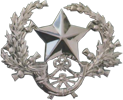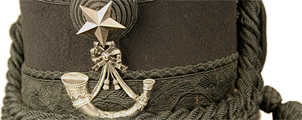1801 - 1900
 The 90th Light Infantry received the first battle honour, Mandora, on its colours in 1801 when it was sent as part of the force to foil Napoleon’s attempt to seize Egypt. The helmet on the right is a replica of that worn by Colonel Rowland Hill during the battle. Hill later progressed to the rank of General.
The 90th Light Infantry received the first battle honour, Mandora, on its colours in 1801 when it was sent as part of the force to foil Napoleon’s attempt to seize Egypt. The helmet on the right is a replica of that worn by Colonel Rowland Hill during the battle. Hill later progressed to the rank of General.
In 1797, the 26th had returned home from Canada, when hostilities in republican France were reignited. In 1808, they joined the army assembled by Sir John Moore to attack the French forces in Spain. Intent on forcing the surrender or annihilation of Moore’s army, Napoleon’s plan failed and the 26th complete and unbroken, reached its base at Corunna in January 1809.
Following service in the West Indies and Canada, the 90th Regiment was then ordered to Belgium, joining the British Army under the Duke of Wellington. Although too late for action at Waterloo, they joined the army of occupation marching on Paris, where it remained for many months.
 The First China war then broke out in 1842 and after a decade in garrison in India the 26th was ordered to join the expeditionary force, taking part in the occupation of Ning Po and the capture of Hong Kong. The cloisonné vase on the right was brought back from China by the 26th and was probably relatively new when first procured.
The First China war then broke out in 1842 and after a decade in garrison in India the 26th was ordered to join the expeditionary force, taking part in the occupation of Ning Po and the capture of Hong Kong. The cloisonné vase on the right was brought back from China by the 26th and was probably relatively new when first procured.
 The 90th were posted from England to the Crimean War in 1854. Harsh conditions and exceptionally cold weather proved particularly trying. Major General H. H. Crealock recorded the hardships and highlights of regimental life in his sketches. The 90th excelled in Crimea, winning two of the VCs displayed in the regimental collection.
The 90th were posted from England to the Crimean War in 1854. Harsh conditions and exceptionally cold weather proved particularly trying. Major General H. H. Crealock recorded the hardships and highlights of regimental life in his sketches. The 90th excelled in Crimea, winning two of the VCs displayed in the regimental collection.
 During the Indian Mutiny in 1857, the 90th were in the unique position of taking part in both the Defence and the Relief of Lucknow. It was at the mutiny that they won a further six Victoria Crosses, one of which was awarded to Patrick Graham for action on 17 Nov 1857, he was elected for this by his fellow soldiers. The Regiment remained in India on garrison duties until returning to Britain and Edinburgh Castle.
During the Indian Mutiny in 1857, the 90th were in the unique position of taking part in both the Defence and the Relief of Lucknow. It was at the mutiny that they won a further six Victoria Crosses, one of which was awarded to Patrick Graham for action on 17 Nov 1857, he was elected for this by his fellow soldiers. The Regiment remained in India on garrison duties until returning to Britain and Edinburgh Castle.
 In 1868, the 26th were selected to join the expeditionary force sent to Abyssinia. The successful mission saw the 26th give protection to the main column marching to the capital, Magdala, from where the Abyssinian prayer book originates.
In 1868, the 26th were selected to join the expeditionary force sent to Abyssinia. The successful mission saw the 26th give protection to the main column marching to the capital, Magdala, from where the Abyssinian prayer book originates.
 The 90th were once again called into action in January 1878, taking part in the Zulu War under the command of Lieutenant-Colonel Palmer, to whom the ivory armlet on the left was presented. They were met with determined resistance and at Ulundi, of the 103 British casualties; over ten percent were soldiers of the 90th.
The 90th were once again called into action in January 1878, taking part in the Zulu War under the command of Lieutenant-Colonel Palmer, to whom the ivory armlet on the left was presented. They were met with determined resistance and at Ulundi, of the 103 British casualties; over ten percent were soldiers of the 90th.
 In July 1881 the 26th and 90th Regiments were amalgamated to form The Cameronians (Scottish Rifles). The shako shown on the right was adopted by both regular battalions of the Regiment.
In July 1881 the 26th and 90th Regiments were amalgamated to form The Cameronians (Scottish Rifles). The shako shown on the right was adopted by both regular battalions of the Regiment.
 Towards the end of the century the 90th were once again called into action for the Boer War in 1899 along with the Militia and Volunteer battalions. There they took part in actions at Ladysmith and Spion Kop where they were praised for holding their position in the face of severe losses with little support. The notebook on the left was in the pocket of Lt Draffen at Spion Kop, saving his life when hit by a bullet.
Towards the end of the century the 90th were once again called into action for the Boer War in 1899 along with the Militia and Volunteer battalions. There they took part in actions at Ladysmith and Spion Kop where they were praised for holding their position in the face of severe losses with little support. The notebook on the left was in the pocket of Lt Draffen at Spion Kop, saving his life when hit by a bullet.


